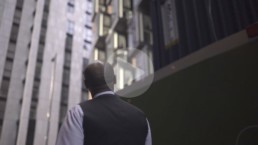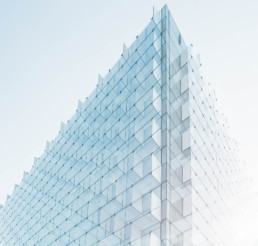Fleximize Funds Eco-Construction Consultancy
Saj Rahman of Maple People turned to Fleximize when looking for a funding partner who would understand the unique challenges of his purpose-driven business.

Constructing office spaces for productivity and performance
At Maple People, we care more about using sustainable building materials and developing innovations in construction than simply designing aesthetically-pleasing office interiors. We put people first – specifically, the people who will be using the space long after our construction team have packed up and left. We believe that office spaces should be designed to enhance the wellbeing and performance of those who will use it for years to come.
For 40 hours a week, most offices are a hive of activity. The people that work in an office may not always notice, but design aspects such as lighting, temperature control, ventilation and the floor-plan itself can all have an impact on their wellbeing. A healthy worker is likely to work harder and perform better.
The quality of an office space can affect up to 10% of a business’ productivity, or the lack of. It is not difficult to do the maths to understand how thoughtful investment at first can look after the the business in the long term.
So, how can office designers ensure that their work contributes to the health and happiness of those that will use their space?
The risks of poor office design
There are many elements of the office design to consider when carrying out a Cat-A and B fit-out, particularly if you wish to create a space that does more than just look good. Here are some of the key features that could negatively affect a high-performing space.
Floor plans
There is a growing body of evidence to suggest that sitting down all day is worse for your health than smoking cigarettes, and that even those who exercise regularly are at risk if they don’t keep moving during the day. But what does this have to do with office design? Well, traditional offices are designed to ensure workers have everything they need within arms reach – so they barely have to leave their desks. And when they do, the important features of the office are repeated in each section to avoid long diversions.
Air quality and temperature
Low-quality air, over-reliance on air conditioning, poor temperature control, and lack of access to ventilation can all lead to health problems and fatigue. We have all experienced the 3 pm -slump on a summer afternoon, where the temperature is rising and the air in the office seems to stand still. This isn’t just bad for employee morale and health, but bad for their ability to be productive, too. And it’s not just the summer months where we can see this happen; cold winter mornings can make workers feel sluggish, too. That’s why the ability to control the temperature and the absence of hot or cold spots is vital in any working space. Research also suggests that the carbon dioxide levels in overcrowded/under-ventilated meeting rooms can contribute to reduced cognitive function – thankfully, only temporarily.
Lighting
Office lighting is something that most of us pay little attention to, but poor lighting and a lack of natural light can contribute to headaches, eye strain, tiredness, and even anxiety or depression. There is a wealth of research available to show that incorporating even a small amount of exposure to natural light into a working day can improve wellness through the release of endorphins, as well as improving the quality of sleep. While regulations state that lighting must be suitable and sufficient, there are no rules as to what exactly this means; it is down to office designers to take responsibility for upholding great standards instead of opting for the minimum requirement – or the cheapest, just because it looks great.
How to design office interiors for wellbeing and productivity
When we add these elements together, it becomes clear that planning your office design in advance is more efficient and sustainable than trying to retroactively address any areas in which the space falls short after construction.
For example, a well-designed, person-centric office space could see the amenities situated more than a short hop away from any desk, with meandering routes that bypass natural light sources to get workers moving and lift their spirits. Temperature control and ventilation that works effortlessly in the background help people to maintain focus without distraction and discomfort. It’s also vital to have a space that looks comfortable, with clean lines and without too much visual ‘noise’ – but that is the primary concern in most traditional office spaces. Today, Maple People and other responsible constructors incorporate that visual design with the need for happy and productive employees, too.
Constructing smart buildings and eco-offices
Traditional construction methods create traditional spaces, but there is a better approach. By employing the latest innovations in construction you give rise to smarter buildings and more environmentally friendly offices. Overall efficiency – both of the build project and resulting space – is improved, reducing costs and the use of vital resources. So why isn’t everyone constructing smart buildings?
As devices to convert your home into a ‘smart home’ continue to take over, there seems to be relatively little interest in using the latest innovations in building projects – particularly offices. But, with numerous benefits to the building owner, business users and even the occupants that will work in the finished space, we believe the smart revolution is coming.
What is a smart office or building?
Traditional offices are built to maintain a relative degree of comfort with regular maintenance. Smart offices are designed to adapt to requirements with relatively little maintenance. For example, they use automated systems to turn systems on and off as required, rather than running at a baseline level in the background all the time. So what does that look like?
Well, your traditional office likely has the lights on constantly throughout the day, even in areas that are not in use, and possibly at weekends too. Electricity supply, heating, devices – everything is ready to go when it’s needed. Smart offices, however, shut down systems that aren’t in use, conserving energy and therefore resources such as fossil fuels and money. They also give the end-user more control over their environment. This control, and the resulting comfort, are important for productivity, but are hard to achieve in a traditional office with just two settings: on or off.
And with these systems comes the ability to monitor, track, and analyze data that inform future strategies for enhancing the workspace. But there is another way to be ‘smart’, too. Some buildings are designed without the need for these automated systems. If you have a natural ventilation loop built-in and make use of natural light, the requirements for active ventilation and lighting can be greatly reduced, or negated altogether; this is also smart.
Why aren’t there more smart buildings?
Smart buildings require a whole new approach to the design-and-build process – and it’s no wonder, when traditional methods of office design still produce spaces that create the same amount of waste as they did two decades ago. By including the waste that will be generated in the planning phase, we can ensure we produce less of it.
I believe that this is due to the fact that our offices are not our homes; it’s not our own money, and decisions are ultimately made by a team of people – diffusing the responsibility to make eco-friendly choices and making it less likely for a radical thinker to come along and ‘rock the boat’. It is time for all of us to stop making excuses – costs, time etc – and start acting as leaders to create better spaces for our people and our planet.
Saj Rahman, Founder and CEO of Maple People
This industry generally relies on regulations and legislation that is passed as a ‘reaction’. But we don’t believe in waiting for a disaster to occur before we start to make a positive change. At Maple People, we believe in proactivity and consideration towards the occupants of these spaces and, indeed, the inhabitants of the planet as a whole.
Examples of smart buildings
The Edge, The Netherlands
The Edge is an office building that outcompetes all others when it comes to sustainability. For a start, the solar panels on the outside of the structure generate more energy than the building itself uses. With nearly 30,000 sensors inside the building, it is possible to ensure every inch of the building expends only as much energy as is required; empty sections of the office are shut down, unneeded lights turn off automatically, cleaning only occurs when it is required and natural ventilation overrides the need for air conditioning.
The general aim when building The Edge was to try anything with a return-on-investment of less than 10 years. The building is a showcase of the latest innovations in construction, and an example of the cost-saving benefits of investing slightly more in the initial outlay in order to reap the rewards; especially in something as long-lived as a working building.
Passive House
Passive House – or PassivHaus – is an architectural movement that spread around northern Europe in the 1990s and has since extended across the globe. This is at the opposite end of the ‘smart’ spectrum to The Edge, as the Passive House buildings do not require sensors to activate or deactivate systems as needed. Passive House buildings are heated, ventilated and cooled by the careful design of the structure instead of requiring active systems to carry out those tasks. With 30% of energy consumption used in heating and cooling of buildings in the EU, these smart designs are of huge benefit both to the occupants (and their wallets) and the environment.
These houses feature all kinds of innovations, such as solar space heating and ground cooling, all enhanced by optimising the orientation of the building to make the most of natural light and internal sources of heat, such as appliances. The initial additional cost of creating a passive house instead of a traditional building is recovered in savings within a decade.
The requirement for insulation and air-tightness (aside from the passive forced ventilation system) leads to a temperature-controlled, quiet, and comfortable environment for the occupants. The Passive House movement creates high-spec living environments in an ethical and sustainable manner, without requiring a vastly bigger budget than traditional homes.
Smart buildings: smart future
At Maple People we are dedicated to this idea of building ‘smart’. We invest our profits back into research and development so that we can be at the forefront of the smart revolution. Our customers don’t have to choose between aesthetics, affordability and ethicality; they can have it all.
The commercial industry (build and usage) is responsible for 40% of the world’s energy demand, and it is here that the wealth lies and where change of a substantial magnitude can happen. Unlike general technology, the construction industry has not changed with the times. It is now that Maple People have begun our journey to change the way we construct. We must look to each other as individuals to drum up the race for change. We are the consumers; we have a choice to make about the mark we leave on this world.
Saj Rahman, Founder and CEO of Maple People
Innovation in construction
Traditional construction methods aren’t cutting it any more. Our customers want more efficient and eco-friendly builds – and the cost-saving benefits these offer. We invest our profits back into innovative research and development projects to ensure we can deliver futuristic shell and core building projects that create a brighter future for the whole planet.
Commercial interior design and builds currently use predominantly traditional construction methods and materials. These methods are concerned with delivering projects on time, within budget, and to spec, which is all that many customers are looking for.
But times are changing, and new – better – methods are available that can deliver all that and even more. At Maple People, we are focussed on smart building, with one eye on delivering brilliant projects on time, and one on using and developing new innovations in order to cut construction and maintenance costs, all while saving the planet from the impending climate crisis.
This isn’t a case of having to choose between the customer’s objectives and the environment – with a dash of ingenuity, we really can have it all.
Benefits of innovation in construction
By using new methods and materials, we deliver sustainable office fit-outs that give us – and our customers – a distinct competitive advantage. Clients benefit from the savings made by using fewer and better materials. Smart office design leads to lower energy consumption and reduces running cost, resulting in sustainable projects. To add to the benefits, enhanced wellbeing is a byproduct of thoughtful design. And finally, the spaces we design and build are exciting and future-proof, as we care about the long-term impact of everything we do.
Our latest futuristic office design
We are currently working on an exciting Cat-A space design and development project where we are applying an ‘energy first’ instead of ‘fashion first’ approach. While the space will be built with the users in mind, and therefore needs to look fabulous, we’re employing some innovation to ensure it is a smart building first and eye candy second.
So how do we do that? First, we look at using as much natural light as possible, to reduce unnecessary energy costs. We are incorporating open spaces in a way that reduces the need for mechanical ventilation and air conditioning. By examining the existing design and working with the current installations, we can create a new version of the space using fewer materials than if we took it all apart to start from scratch.
We also look at the existing installations and fixtures and get to work designing our new space around it, rather than ripping it out and starting again. As a result, the outcome can be surprisingly beautiful, with stories behind them reflecting the history of the space, another surprising byproduct of thoughtful design.
Inspiration: the ultimate smart building
Every great designer relies on inspiration to help them formulate world-changing ideas. At Maple People, we are awe-struck by The Edge, in The Netherlands. Also described as ‘the world’s greenest building’, this is a cutting-edge example of innovation in construction and sustainable design. With a sustainability score of 98.4% and a handy app that ensures everyone within the building is comfortable, without wasting any energy at all, it’s a revolutionary piece of design and construction.
The Edge gathers a huge amount of data, which can be used to make smart decisions – such as closing sections of the building on quieter days to reduce running costs and energy consumption. From the underground parking and the robotic cleaners, to the coffee machines, everything is ‘smart’. The underlying belief of the designers is that one day, buildings like these will be everywhere. But we’re still a long way from that reality.
The future of smart buildings
At Maple People, we are proud to be ahead of the game when it comes to sustainable office fit-outs. The industry is slowly moving towards a more sustainable future, but we are trailblazing a path by carrying out our own research and development. We are all-too familiar with the challenges in this space, and are actively gathering resources and expert teams to ensure that considerate design becomes the norm instead of a rarity.
We see pockets of innovation occurring in the industry, but the majority of commercial interior design is solely focussed on aesthetics, without a thought to sustainability. We combine both of these things, which is surely a win-win for the client, the end-users of the space, and society as a whole.






